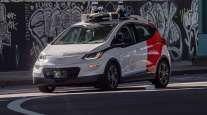House Passes Bill to Speed Introduction of Self-Driving Vehicles

U.S. House lawmakers passed a wide-ranging bill to speed the introduction of self-driving vehicles championed by tech and auto companies racing to develop and deploy the technology.
“With this legislation, innovation can flourish without the heavy hand of government,” Ohio Republican Bob Latta said on the House floor ahead of the voice vote in the chamber Sept. 6. Latta is chairman of the House Energy and Commerce subcommittee that developed the legislation.
The action now moves to the Senate, where Republican John Thune of South Dakota and Democrats Bill Nelson of Florida and Gary Peters of Michigan are leading work on legislation of their own. The trio serve on the Senate commerce committee, which on Sept. 6 announced a Sept. 13 hearing to examine autonomous commercial vehicles and how they may fit into the Senate’s self-driving vehicle legislation. The House bill only applies to passenger cars and light trucks.
The House bill would put the National Highway Traffic Safety Administration in charge of regulating self-driving car safety and preempt competing rules at the state level. Manufacturers would eventually be able to introduce as many as 100,000 self-driving cars per year that don’t comply with current safety rules that assume the presence of a human driver. It also instructs NHTSA to develop new standards for self-driving cars. Companies must draft security and privacy plans for autonomous vehicles and document their approach for ensuring self-driving car safety.
“If we’re going to stay at the forefront of innovation and technology in this country, we have to be driving the technology for autonomous vehicles,” Michigan Democratic Representative Debbie Dingell said before the vote. “I’m really proud of the fact that we got this out of the House. We kept our heads down.”
Bipartisan support propelled the bill to the House floor, as the House Energy and Commerce committee unanimously cleared the measure in July. The lopsided vote came in spite of concerns raised by some Democrats and criticism over the lack of input on the bill from NHTSA, which still doesn’t have a top official appointed by the Trump administration.
Proponents say self-driving vehicles could help eliminate the human error responsible for some 94% of the more than 30,000 fatal vehicle crashes in the U.S. each year. The issue has gained a sense of urgency after a rise of deadly crashes in recent years following a period of decline.
Trade groups representing companies such as Alphabet Inc.’s Waymo, Ford Motor Co., General Motors Co., Lyft Inc. and others working on the technology voiced strong support for the bill. Labor unions successfully lobbied to exclude tractor-trailers, buses and other commercial vehicles from the House bill.
“Automakers have been developing these technologies for years and this legislation helps address a variety of barriers that otherwise block the ability to safely test and deploy these vehicle technologies,” the Alliance of Automobile Manufacturers, a Washington-based trade group for GM, Ford, Volkswagen AG and several other automakers, said in a statement.
Safety advocates have raised red flags. The Advocates for Highway and Auto Safety told lawmakers in a letter on Sept. 5 that expanding the cap on safety exemptions to 100,000 vehicles per year could be dangerous and that the bill’s preemption of state authority is overly broad. The group also urged additional funding for NHTSA.
The Trump administration meanwhile will put its first formal stamp on autonomous vehicle policy when the U.S. Transportation Department releases updated deployment guidance later this month. The non-binding policy was first issued by the Obama administration in September 2016 to provide some basic safety guidelines for autonomous vehicles while stopping-short of issuing new regulations.




